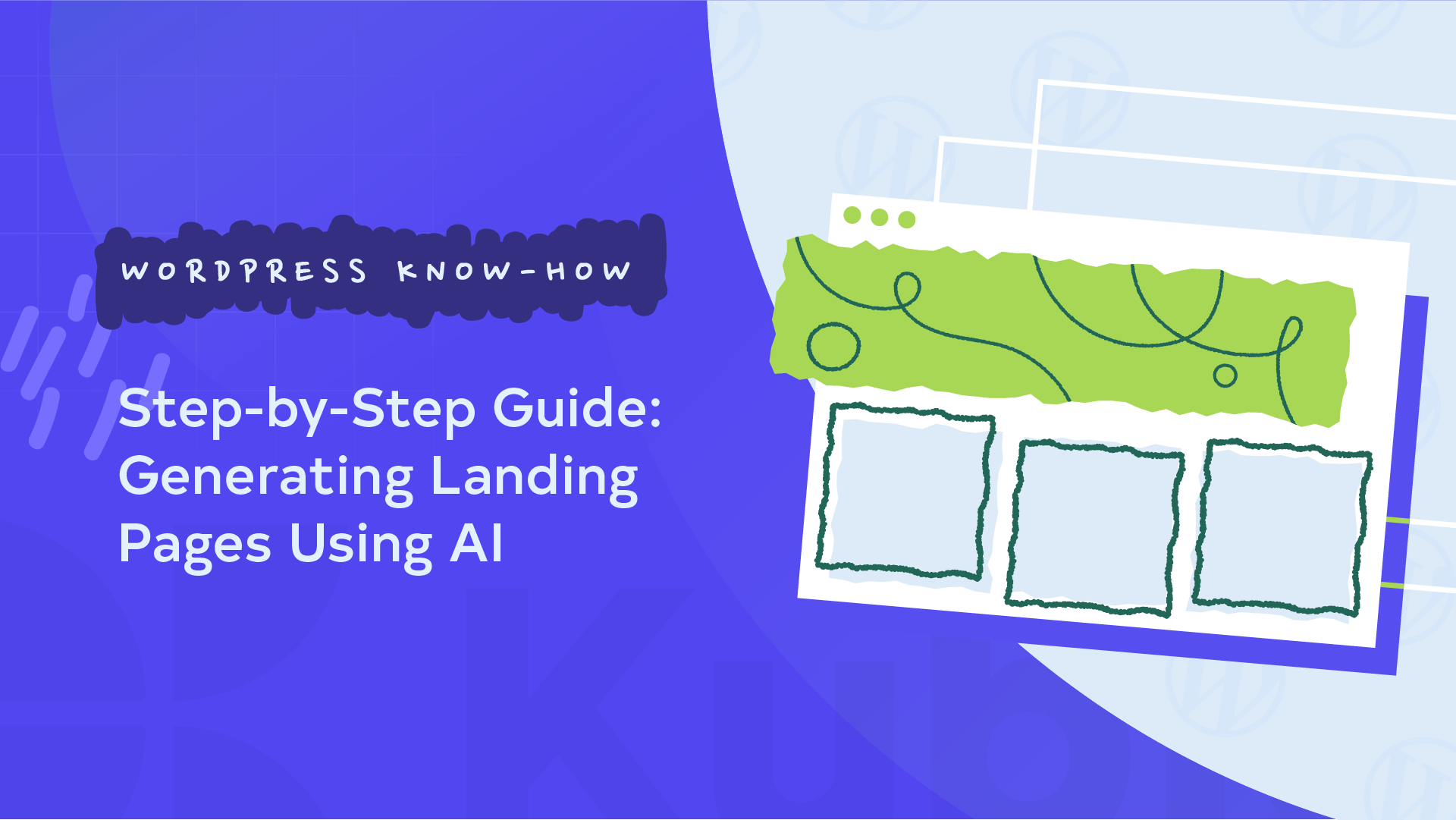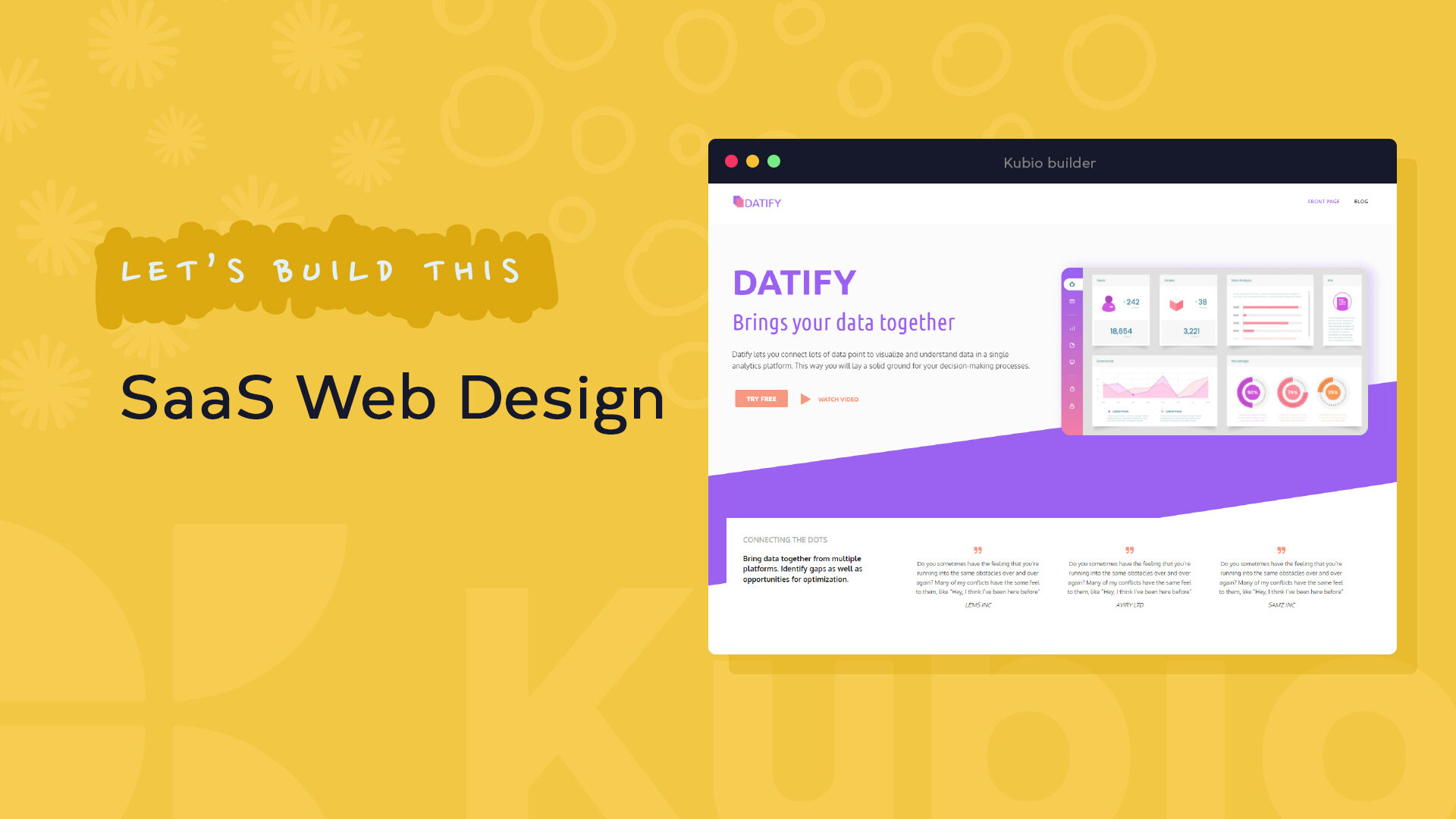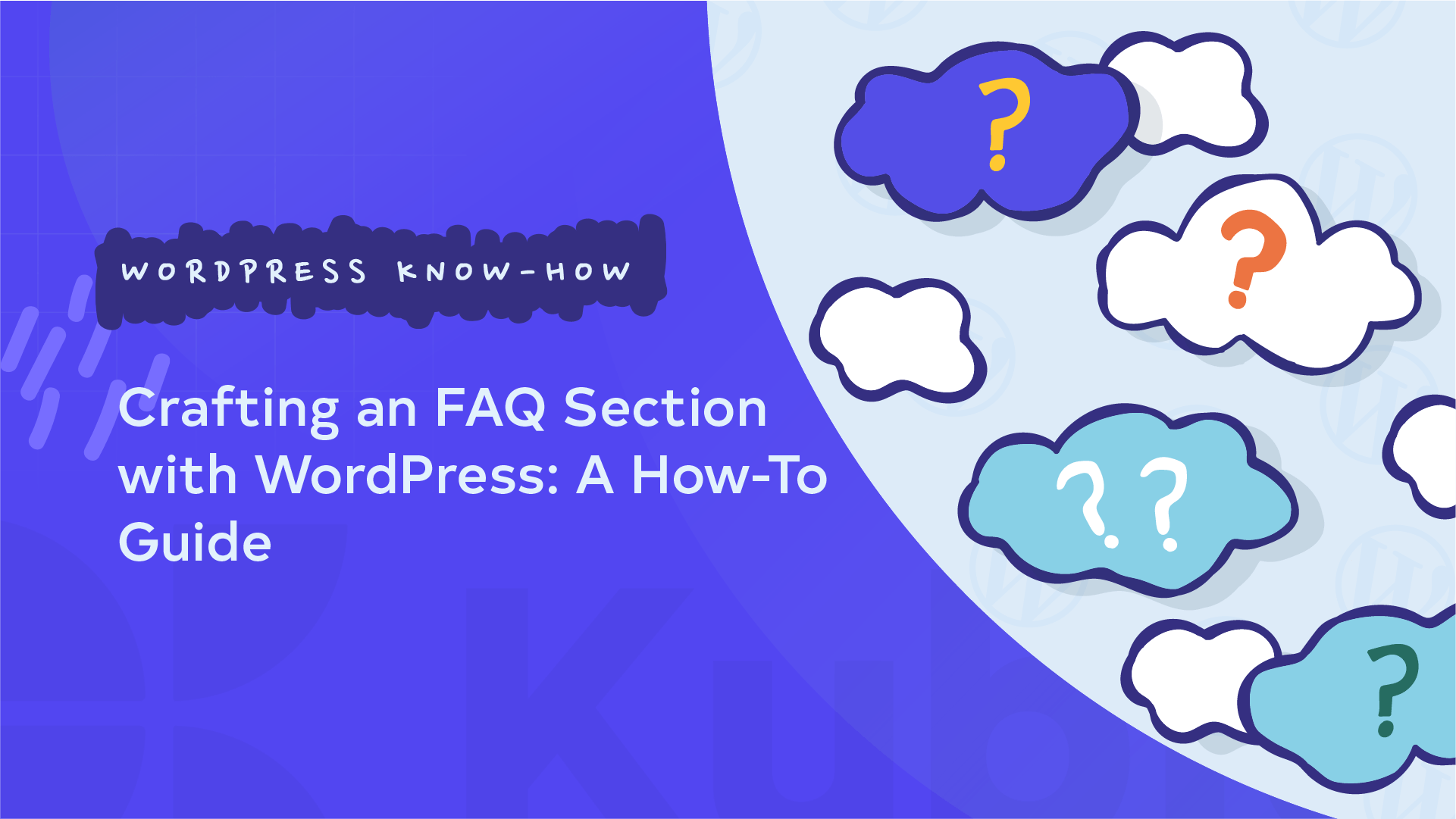The use of AI for landing page creation is revolutionizing the way marketers, content creators, and business owners approach website development. AI simplifies and expedites the process of building landing pages, eliminating the need for extensive manual coding or design expertise.
Some may worry about losing the personal touch or control over the creative process, but it’s worth remembering that AI should enrich the act of website design, not replace it. It improves the creative process by way of providing a great foundation from which to build your customized site.
In this article, we’ll look at a few of the AI website-building tools out there, as well as walk you through a step-by-step guide on creating engaging WordPress landing pages using Kubio AI. Let’s explore the future of landing page creation, where efficiency meets creativity!
Choosing your tools: Comparing AI landing page builders
The first step is selecting the right AI tool that meets your specific needs. The market offers various options, including AI WordPress themes, each designed with different user needs in mind. Identifying the tool that aligns with your objectives is crucial for a seamless and successful landing page creation experience.
Here are some factors to consider when choosing an AI landing page builder:
- Ease of use: The tool should have an intuitive interface that makes it easy for users of all skill levels to navigate and create landing pages.
- Customization capabilities: It should offer a wide range of customization options to ensure that the landing page reflects your brand’s identity and meets your specific needs.
- Integration with existing platforms: The ability to integrate seamlessly with your current marketing tools and platforms is essential for a unified digital strategy.
- Cost: Consider the tool’s cost to your budget and the features it offers to ensure it delivers value for money.
It’s important to select a tool that matches your skill level, business needs, and marketing objectives. Reading reviews and testimonials, along with trying out demos, can provide valuable insights into how a tool performs in real-world scenarios and whether it’s the right fit for you.
Let’s take a look at some of the tools available for this purpose:
1. Kubio AI
Kubio AI comes highly recommended due to its ease of use, extensive customization capabilities, and seamless integration. Its cost-effectiveness makes it an ideal choice for anyone looking to leverage AI in landing page creation.
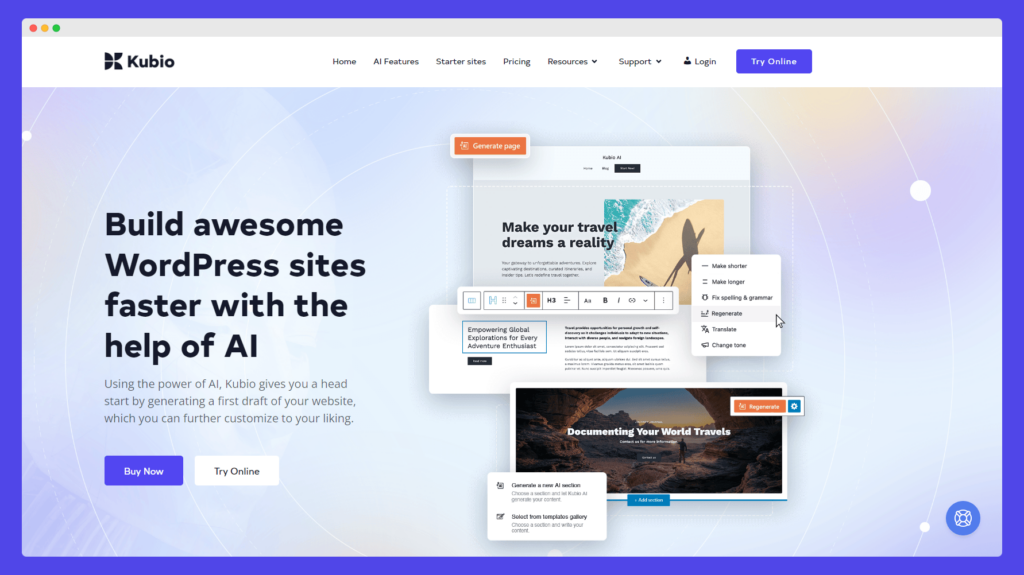
The Kubio builder itself is already super easy to use, but the AI tool brings that simplicity to the next level. By simply following a startup wizard and answering a short series of basic questions about your business and website, you can instantly generate a first draft of your whole website.
You can also use AI credits to create or modify specific elements of your landing pages, such as generating new stock images and adjusting the length or tone of landing page copy. Whether you want to use AI to create a whole site or refine a stand-out landing page, Kubio’s a great tool for the job.
2. Elementor AI
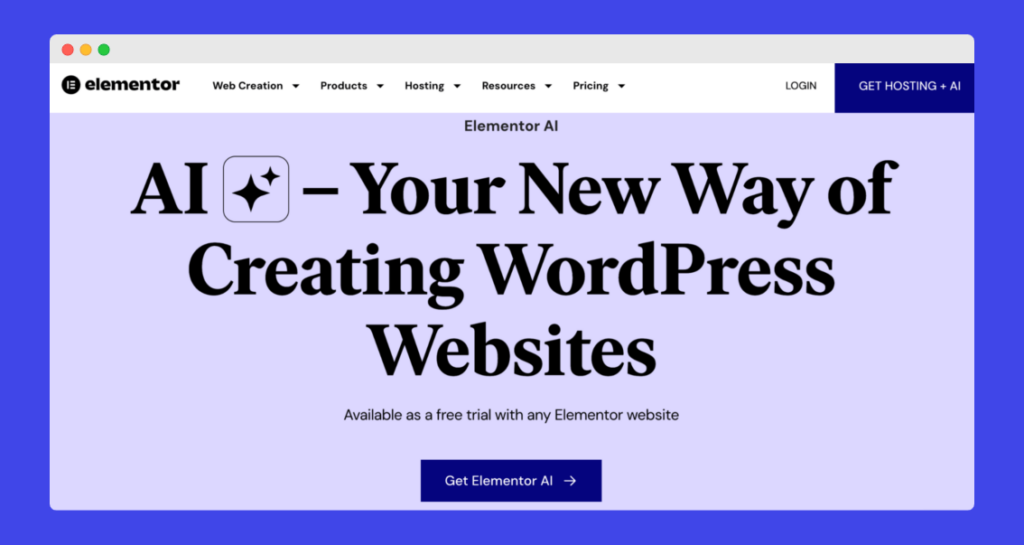
Elementor is another web builder with AI capabilities. In addition to being able to offer block-based building support and AI copy generation, the Elementor AI tool can also save and learn details about your site and business. This means that over time, it should start generating better and better results for your site creation.
However, it does come with the potential drawbacks attached to Elementor itself. For example, many users on the platform face issues with site speeds and bloating, and find they need to add caching solutions to keep the site running quickly while using the builder. Moreover, Elementor can come with a learning curve in order to make the best use of both the builder itself and the AI tools.
3. Divi AI
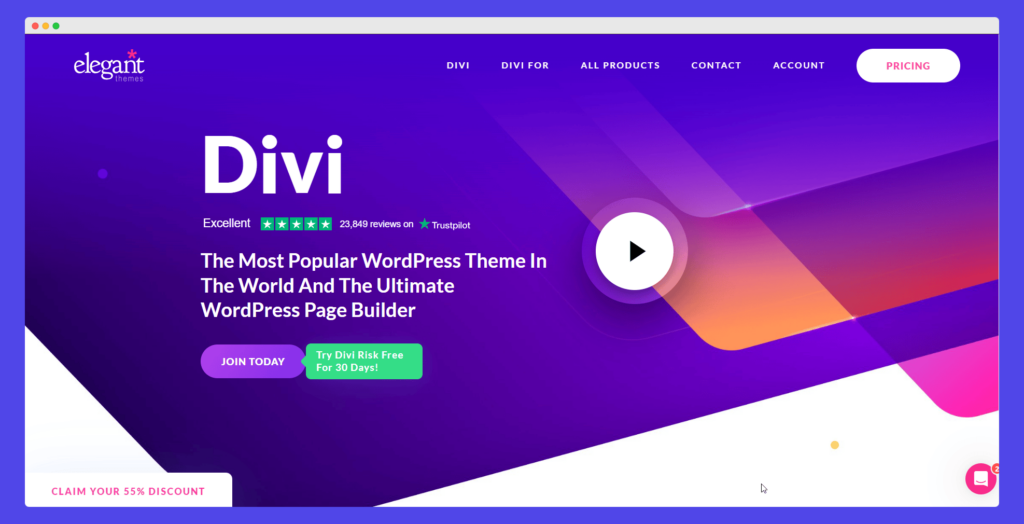
The Divi AI builder, another WordPress-specific option, makes it easy to quickly and easily generate high quality content within the Divi builder. It makes generated text that’s tailored specifically to your website’s goals, and generates images right in the builder.
That said, some users find that Divi also can cause a negative impact on site performance, especially for older sites. Divi themes typically rely on a lot of shortcode, so it can be difficult to switch themes later on. Lastly, some reviews report that the editor itself is clunky and hard to use, and it can be overwhelming for beginners, due to too many customization choices. As a result, a lot of Divi-built websites look extremely similar to one another.
4. Unbounce

Unbounce is another non-WordPress specific landing page builder. Like the other options on this list, it integrates AI into several parts of the landing page creation process, but one of the most exciting its its AI powered sales and signups optimizer. You can set up “Smart Traffic,” which will automatically funnel users to the landing page most likely to work for their demographic. This allows you to make different versions of your website specifically targeting different audience segments, making for more effective marketing.
Moreover, Unbounce offers a suite of services alongside its landing page building tools, meaning you can get a lot out of this service. You can integrate marketing apps and run A/B testing to build a site that truly meets your goals. Although it’s not built exclusively for WordPress, it does have integrations and themes for the CMS specifically, so it’s not too much trouble to get your design onto your site.
5. MakeLanding
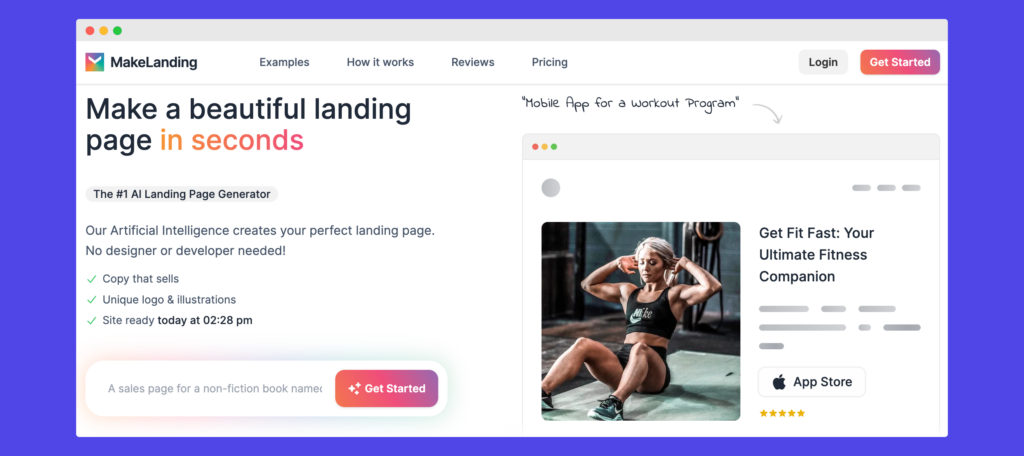
MakeLanding is a handy tool that allows you to quickly generate a professional-looking website without any design or coding skills. Reviews praise its speed and efficacy, and also note that the AI creates persuasive, compelling copy. It comes with a wide selection of unique templates site owners can use as launch pads for their own ideas and designs. It’s a fast and cost-effective way to build professional landing pages without needing a designer or developer, making it accessible to a wide range of users.
It may not be a perfect fit for WordPress users since, at this time, there’s no direct integration with the WordPress platform. Instead, it generates the HTML code for the website you design. However, there are a few ways creators may be able to use this tool, if they’d like. For example, you can take the code generated and manually add that code to a blank page template in WordPress. This would allow you to host the AI-generated landing page on your site – however, it may not be a seamless integration, and you’d want to test the page rigorously to be sure it worked as intended.
Standalone AI tools vs WordPress-integrated AI tools
AI tools are indispensable for creating content, optimizing SEO, and enhancing overall website functionality. These tools can be broadly categorized into two types: standalone AI tools and WordPress-integrated AI tools.
Understanding the difference can help you decide which to use for your landing page creation and website optimization efforts. The above tools are all integrated into WordPress, which means you can access them from your WordPress dashboard and they’re designed to work well and within the WordPress system.
Standalone AI tools, such as ChatGPT for text generation and Dall-E for image creation, operate independently of any specific platform. These tools are versatile and can be used for a wide range of applications beyond website development.
However, their independence means that integrating their outputs into your website, especially if managed through WordPress, can require additional steps. This might involve manually copying and pasting generated content, adjusting formatting, or coding to ensure compatibility.
How to easily generate a landing page using Kubio AI
Here’s how to create your own AI-powered landing page with Kubio:
- Initial setup: Begin by accessing the Kubio builder. For a comprehensive experience, use the Generate Front Page wizard, which guides you through the initial setup, following the steps in the guide.
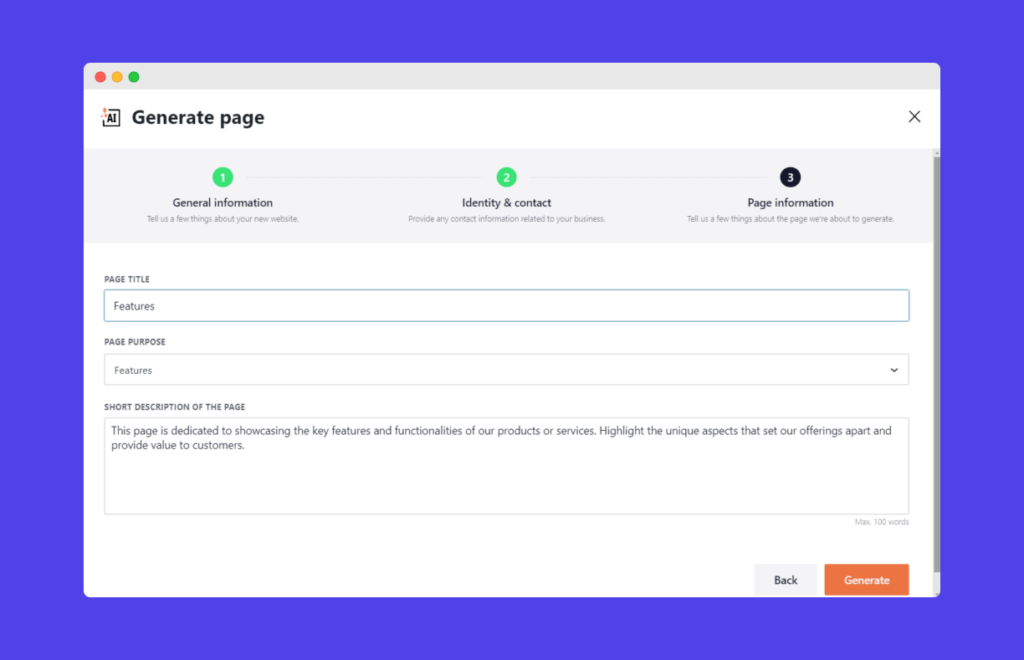
- Customization options: After generating the first draft, Kubio AI offers extensive customization options. You can adjust the color scheme, typography, and layout structure to match your brand identity. The platform’s drag-and-drop builder further simplifies this process, allowing you to tweak every aspect of your pages, including your all-important sales pages, without needing to code.
- Using AI credits for detailed customization: You can use your AI credits to refine individual sections further, such as the background images, landing page copy, or header text. Exit the initial wizard and select the specific sections you want to enhance with AI-generated content.
- Previewing your page: At any stage of the creation process, you can preview your landing page to see how it looks in real time. This feature is crucial for making adjustments on the fly and ensuring the page meets your expectations.
- Saving the first draft: Once you’re satisfied with the draft, save it. This action doesn’t finalize your page but allows you to secure your progress. You can come back to make further adjustments or add more content as needed.
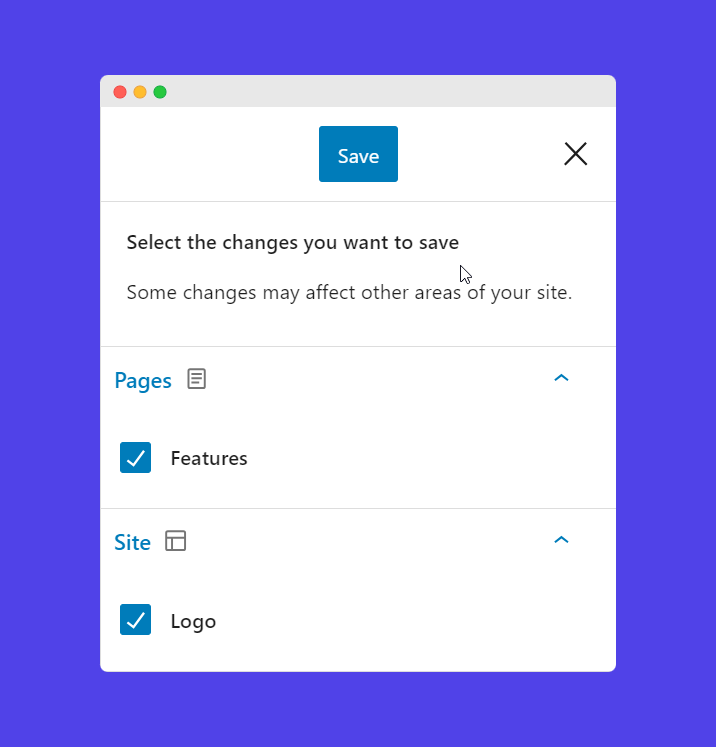
Prompt engineering tips for success
- Clarify your vision: Before crafting your prompt, consider what you want your landing page to achieve, who your target audience is, and what message you want to convey.
- Be brief and specific: Kubio AI’s landing page builder asks for a description length of 30 to 100 words. A concise, information-dense prompt can often be more effective than a long, detailed one.
- Regenerate and refine: If the initial output from Kubio AI falls short of your expectations, the platform’s regenerate feature lets you modify the content, such as changing the length or tone of your landing page copy.
Create fantastic landing pages with Kubio AI
Designing a landing page manually can be challenging, especially considering the time, technical expertise, and creative effort required to create a page that looks appealing and effectively drives conversions.
With its advanced AI capabilities, Kubio AI simplifies the process of creating landing pages, empowering users to produce SEO-friendly text and diverse image types based on specific keywords or prompts. Additionally, it enables the generation of a comprehensive first draft of a website with minimal input.
Kubio AI’s intuitive platform ensures that anyone, regardless of their technical know-how or design skills, can create professional-looking landing pages that are optimized for conversions. Don’t let the complexities of landing page creation hold you back. Download Kubio AI today and start building engaging, effective landing pages.


